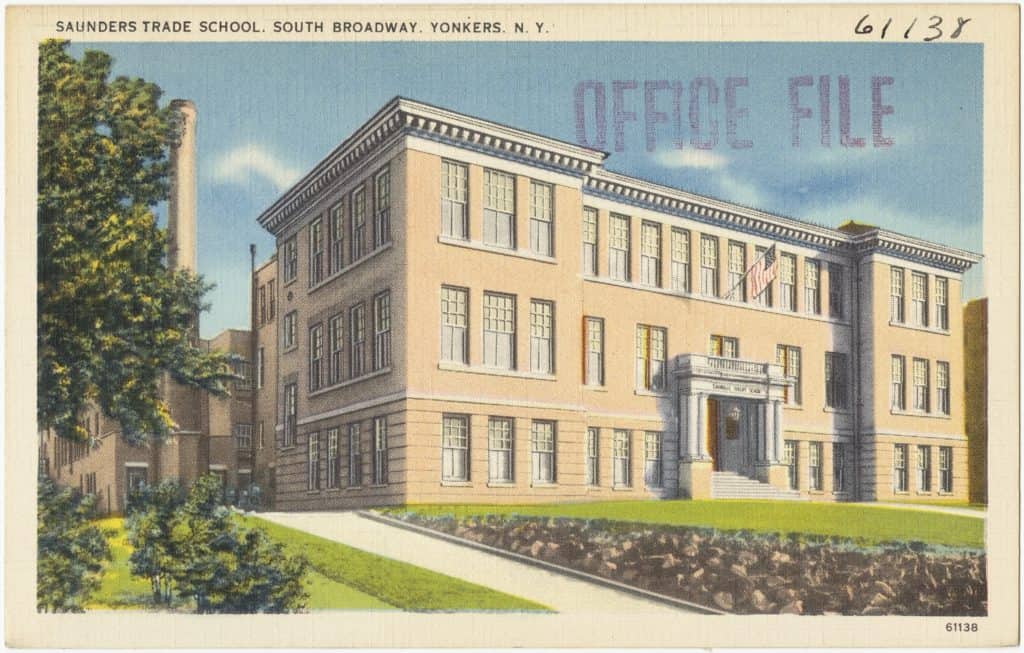
By Mary Hoar, President Emerita, Yonkers Historical Society, recipient of the 2004 Key to History & President Untermyer Performing Arts Council
Monday, May 10th
May 10, 1869: A “slight smash-up” caused by a runaway freight car, not only caused the train to run through the carhouse into the creek, it knocked over the iron water tank into the water! Besides scaring the fish, it crushed several small boats. The freight? Dried peas for Messrs. Peck & Company.
May 10, 1946: Hundreds of St. Joseph’s Seminary students gathered on the lawn to witness Francis Cardinal Spellman of New York and Bernard Cardinal Griffin of Westminster, England, plant oak trees to memorialize their visit.
May 10, 1956: The Kiwanis sponsored Saunders Key Club donated a movie projector to the school for educational purposes. While making the presentation, James Cranston said the club was organized to be a “junior civic organization working in the bests interest of the student body and the school.”
Tuesday, May 11th
May 11, 1914: After a suggestion by Congressman W. R. Oglesby, the Post Office inaugurated electric car mail service between Yonkers and Mount Vernon.
May 11, 1920: Alderman Oscar Barker ordered the Forestry Bureau to plant 14 maple trees in Glen Park. Barker bought the trees himself to pay tribute to the men in the Second Ward who lost their lives in the World War.
May 11, 1940: School Superintendent Ankenbrand announced Yonkers had spent $160, 727.46 to convert former School Twenty into the new Longfellow Junior High School.
Wednesday, May 12th
May 12, 1943: Almost 7,000 people marched in the Yonkers “I Am An American Day” parade; the parade ended at Larkin Plaza, where Yonkers officials held a united nationalities program with keynote speakers City Manager William Walsh and Mayor Benjamin Barnes.
May 12, 1949: The American Labor (ALP) party’s attempt to hold an early morning shopgate rally near the Otis Elevator plant was sabotaged by company employees! ALP had a permit to hold a rally between 6:30 and 7:00 am; its speakers arrived in a jeep and parked near the Otis Guard Office on Wells Avenue, half a block from Police Headquarters. Each time a speaker tried to talk using their PA system, Otis workers blew their car horns so loudly it was impossible to hear anyone.
Thursday, May 13th:
May 13, 1917: Employees of the Yonkers Health Bureau formed a Garden Community Club! Led by President James Hanrahan, the club found property on Central Avenue to use for their war gardens.
May 13, 1945: Yonkers’ air raid sirens were sounded at 1 pm to summon the people of our city to a 3:00 pm veterans’ observance in Larkin Plaza. Although celebrated on Mother’s Day, thousands of Yonkers residents came to witness ceremonies giving thanks for the victory in Europe and tribute to the servicemen overseas and on the home front. Chairman of the Central Committee of War Veteran Organizations William Scott opened the program; other speakers were Mayor Curtiss Frank, Chairman of the Yonkers War Council Kristen Kristensen, Major Andrew McLean and Assemblyman Malcolm Wilson. One of Pershing’s buglers, WI veteran Thomas Pyne, sounded taps, and all prayed for an early end to the hostilities in the Pacific.
Friday, May 14th
May 14, 1910: Colonel John Shotts of the Grand Army of the Republic was asked to arrange an inspection of our Soldiers and Sailors Monument on the grounds of Manor Hall; it was cracking in several places.
May 14, 1932: Yonkers resident Captain George Fried of the United States liner President Roosevelt, already hero of two thrilling rescues, added another gripping rescue to his credit fifty yards off the coast of Ireland. On a transatlantic flight to Paris, pilot Lou Reichers ran into trouble. Winds had forced him off course, and he was low on fuel. He spotted the lights of the Roosevelt, and headed toward the ship. The ship’s lookout spotted his monoplane fluttering to the surface of the Atlantic; Fried immediately launched a lifeboat to rescue the pilot. Forced to land his plane near the liner because of a cracked engine wing, damaged fuselage and fuel shortage, Reichers had to be pulled from the pilot’s seat, and was so exhausted, the men had to carry him aboard. The sea was so turbulent, both the plane and the lifeboat were lost.
Saturday, May 15th
May 15, 1935: Without explanation or discussion, the Yonkers Board of Education replaced Board Secretary Ray Halpin, who had served in the position for nine years. Instead, they named his assistant Edward Bashford by a vote of seven to two. President of the Board was Maurice Blinken, grandfather of US Secretary of State Antony Blinken.
May 15, 1944: Company I, 56th Regiment, New York Guard, held memorial services at the Armory for Lieutenant J. Alvin Ross of Woodworth Avenue, the first company member to lose his life in the war. Commander James Arbuckle placed a gold star next to Ross’ name on the honor roll of company members in the service. After Arbuckle read Lt. Ross’ record, enumerating his European combat duty accomplishments in the Army Air Corps, the company presented arms and “Taps” were sounded in his memory. Ross had served as a navigator-bombardier, and was reported killed in action in England.
Sunday, May 16th
May 16, 1925: International operatic star Hubert Wilke announced his retirement. Wilke, who performed before millions on two continents, decided to return to his home in Yonkers to “settle down!” He later taught vocal culture at his daughter Hubertine’s music school, and become active in the cultural and artistic life of our city.
May 16, 1942: The Yonkers Control Room received a “blue caution” air raid signal; this signal sent 10,000 elementary school children home on dismissal orders, and an equal number of secondary students were sent to emergency centers in their schools.
For more information on the Yonkers Historical Society, Sherwood House and our upcoming events, please visit our website www.yonkershistoricalsociety.org, call 914-961-8940 or email yhsociety@aol.com.





